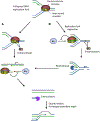Dangerous liaisons: Fanconi anemia and toxic nonhomologous end joining in DNA crosslink repair
- PMID: 20670885
- PMCID: PMC6591721
- DOI: 10.1016/j.molcel.2010.07.016
Dangerous liaisons: Fanconi anemia and toxic nonhomologous end joining in DNA crosslink repair
Abstract
The proper choice of repair pathway is critical to tolerating various types of DNA damage. In a recent issue of Molecular Cell, Adamo et al. (2010), along with a second report (Pace et al., 2010), describe how the Fanconi anemia (FA) pathway is involved in preventing aberrant DNA repair. These studies suggest a potentially significant new opportunity for the treatment of FA.
Copyright 2010 Elsevier Inc. All rights reserved.
Figures

Comment on
-
Ku70 corrupts DNA repair in the absence of the Fanconi anemia pathway.Science. 2010 Jul 9;329(5988):219-23. doi: 10.1126/science.1192277. Epub 2010 Jun 10. Science. 2010. PMID: 20538911
-
Preventing nonhomologous end joining suppresses DNA repair defects of Fanconi anemia.Mol Cell. 2010 Jul 9;39(1):25-35. doi: 10.1016/j.molcel.2010.06.026. Mol Cell. 2010. PMID: 20598602
References
-
- Adamo A, Collins SJ, Adelman CA, Silva N, Horejsi Z, Ward JD, Martinez-Perez E, Boulton SJ, and La Volpe A (2010). Mol. Cell 35, 25–35. - PubMed
Publication types
Grants and funding
LinkOut - more resources
Full Text Sources
Other Literature Sources

